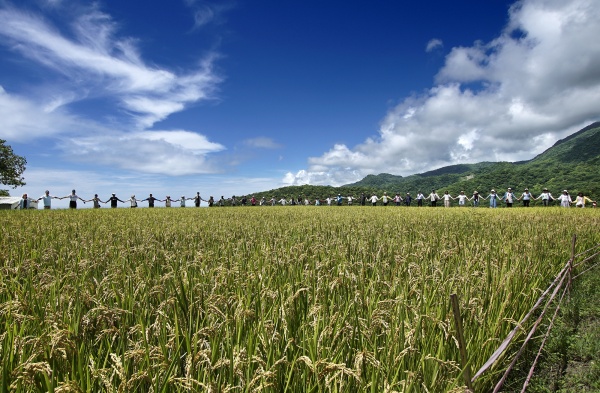IPSIの活動

日本の農村景観の回復を通じたSEPLSのレジリエンスに関する相互学習
Lead organization: Akita Satoyama Design
Other participating organizations: Akita International University, Conservation, InternationalAkita Prefecture, Oga City
1. Background
There are many locations around the world where societies have existed in harmony with nature for centuries but now threatened by rapid socio-economical changes. In Japan, these changes have surfaced mainly as the deterioration and abandonment of farmland or production forests due to the aging and shrinking population of rural villages, and the consequent decline in local culture and biodiversity in production landscape. In such abandoned land, the well-balanced ecosystem has been disrupted and invasive alien species are threatening local species. And the production forests that are not properly managed will lose their water-holding capacity and the disaster-prevention function. In addition, the traditional wisdom and culture that have been passed down in these production landscape will also be lost. It is urgently required to restore sustainable landscapes and balance biodiversity conservation and sustainable use in those areas.
In April 2022, two IPSI member organizations, Akita International University and Conservation International, along with another organization Akita Satoyama Design who is applying for the membership, have started a collaboration in a production landscape in Akita where depopulation is happening at the fastest rate in Japan. We aim to redefine satoyama within the local community from a modern perspective, working with local communities, governments, and other stakeholders, by developing programs for building capacity and creating and rediscovering knowledges from satoyama.
2. Objective
The aim of this project is to build capacity of landscape management in SEPLS in rural Japan by collaboration and mutual learning between the implementing organizations and people in the community.
3. Activities
- Assessment of the resilience in the target community by using the Indicators of Resilience in SEPLS
- Value creation of the abandoned farmlands in the target area by reusing them in multiple ways, such as cultivation, education, and so on. (Collaborative activities with Akita prefectures are going to be held)
- Public Relations activities through both online and offline media about lifestyles in the target area.
- Study sessions to share knowledges and skills, case studies which will support improving site-based actions and mainstreaming biodiversity in production landscapes
- Community survey on flora, fauna and traditional culture
- Recommendations for the regional biodiversity strategy to integrate practice at community level
4. Expected Outcomes
- Community will understand the issues in the target area and share their vision with stakeholders to work together on adaptive management of their landscape.
- Community’s capacity of landscape management will improve.
- Local flora and fauna will be made known, effectively conserved and become indicators of biodiversity in the area. Traditional knowledge and skills are protected and will go down to future generation.
4. Actors and Task Sharing
Akita Satoyama Design is leading the on-the-ground demonstration to restore production landscape and increase the value of the landscape, make it widely known to the public, with its knowledge partners Akita International University (AIU) and Conservation International (CI). These partners will focus on knowledge generation and recommendations. AIU will leverage its network of foreign academic institutions and students to bring external perspectives and scientific knowledge to the activities in Kotokawa to discover new value in the site. CI will support capacity building and knowledge sharing based on its landscape approach and extensive experiences in adaptive management of SEPLS.
5. Relevance to the IPSI Strategy and IPSI Plan of Action
This project will address priority actions under Objective 1 of IPSI Plan of Action 2013-2020:
b. Promote mechanisms for effective knowledge sharing, utilizing the full range of communication materials from organizations working with SEPLS
-> Information collected in the field will be used to generate knowledge products, such as visual book for awareness raising.
c. Build on and further map SEPLS around the world at local, national, regional and global levels to further enhance knowledge generation and sharing, and communicate lessons and experiences.
-> Information collected in the field will also be integrated to a map.
g. Exchange knowledge and lessons learned, and feed synthesis into relevant policy discussions
-> Exchange of knowledge and lessons learnt will be performed in study sessions.
There will be other actions which falls under Objective 4 of the Plan:
b. Facilitate efforts to feed and implement the SEPLS concept into key policy programmes and plans, including NBSAPs/LBSAPs.
-> Lessons learnt and knowledge obtained will inform the regional biodiversity strategy of Akita Prefecture in the next revision in 2026.
c. Increase awareness of policy and decision-makers on SEPLS and IPSI by promoting education, information dissemination and document production.
-> An awareness raising event will be organized in partnership with Akita Prefecture per the Prefecture’s biodiversity strategy.
6. Resources, Funding
The project is proposed as a three-year activity to Keidanren Nature Conservation Fund (KNCF). JPY2,680,000 (approximately USD20,000) has been granted, , and another JPY11,578,000 will be requested for the second and third years.
Project Period: April 2022 – March 2025
7. Monitoring and Reporting
The progress is reported bi-annually to the donor, Keidanren Nature Conservation Fund, and summary update will be provided to the Steering Committee using Annex 1 annually.


